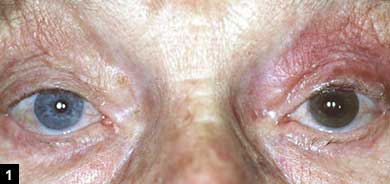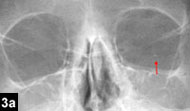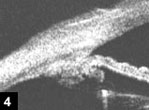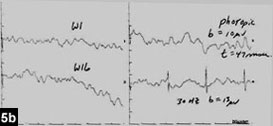Man referred for unexplained, progressive visual loss
The patient had a corneal abrasion in the left eye 1 year prior to presentation.
![Grand Rounds at the New England Eye Center [logo]](/images/commonart/grandroundslogo.gif)
An 88-year-old man was referred from an outside ophthalmologist for progressively worsening vision in his left eye for the past 4 months. His documented visual acuity on his last eye exam 1 year ago was 20/30 in the left eye. He reported no pain, redness, photophobia or discharge.
His ocular history included bilateral cataract surgery 2 years prior and corneal abrasion in the left eye 1 year prior. He had no history of ocular infections. He was being treated for hypertension, diabetes, coronary artery disease and arthritis. He had no known drug allergies. His family and social histories were noncontributory.
External examination revealed iris heterochromia (Figure 1). The right eye was blue in color and the left eye was greenish-brown.
![Shazia Ahmed, MD [photo]](/~/media/images/news/print/ocular-surgery-news/2007/01_january_1/ahmed_70_90_19959.jpg) Shazia Ahmed | ![My Hanh T. Nguyen, MD [photo]](/~/media/images/news/print/ocular-surgery-news/2007/01_january_1/nguyen_70_90_19959.jpg) My Hanh T. Nguyen |
Differential diagnosis
Before revealing the rest of the examination, let us consider the differential diagnosis for heterochromia iridis. Figure 2 lists congenital and acquired causes of hypochromic and hyperchromic heterochromia iridis. For this 88-year-old patient, the etiology is likely to be acquired. Acquired hypochromic iridis can be caused by Fuchs’ heterochromic iridocyclitis, nonpigmented tumors (eg, lymphoma, leukemia, metastatic cancer) and trauma leading to iris atrophy. Acquired hyperchromic iridis can be caused by pigmented tumors (eg, melanoma), siderosis bulbi, neovascularization of the iris, long-standing hyphema due to deposition of blood products and use of medications (eg, latanoprost).
Clinical findings
On ophthalmic examination, the patient’s best corrected visual acuity was 20/30 in the right eye and 20/60 in the left eye. His IOP, extraocular muscle movements and visual fields to confrontation were all normal. His right pupil was appropriately reactive, but his left pupil was fixed at 5 mm. There was a small afferent pupillary defect in the left eye.
On slit-lamp examination, both eyes were white and quiet. The right cornea was clear. The left cornea, however, had a linear scar at the 8 o’clock position and diffuse, brown, anterior stromal deposits (Figures 2a and 2b). The anterior chamber was deep and quiet in both eyes. Although there was iris heterochromia, no iris masses or neovascularization were appreciated in either eye. IOLs were in good position in both eyes.
Dilated funduscopic examination revealed normal nerves and vessels in both eyes. There were decreased foveal reflexes and mild retinal pigment epithelium changes in both eyes. The periphery was normal in the right eye. The left periphery, however, revealed inferior atrophy and vitreous debris.
|
|
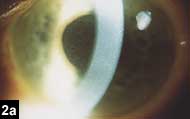 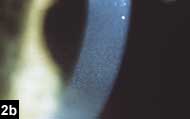 Slit lamp photographs of patient’s left eye reveal diffuse, brown, anterior stromal deposits (2a, low magnification; 2b, high magnification). Images: Nguyen MHT, Soukiasian SH |

What is your diagnosis?
Progressive visual loss

Based on clinical history and examination, siderosis bulbi was highest on our differential diagnosis.
Evaluation
Upon further questioning regarding his previous left eye corneal abrasion, the patient reported that 1 year prior, while working with wood and a chisel and no safety glasses, an unknown particle hit his left eye. Per the patient, this injury was treated with an antibiotic drop and subsequently healed completely. Medical records revealed that this injury resulted in a full-thickness corneal-scleral laceration that was Seidel positive with pressure. In addition, his left eye experienced significant corneal edema, microhyphema, IOP of 33 mm Hg and vitreous hemorrhage. Because the wound was self-sealing, his ophthalmologist treated him with a contact lens and antibiotics with resolution of these signs. No imaging studies were performed.
Subsequent to our evaluation, a series of tests was ordered. Plain films of the patient’s orbits were obtained, both in upgaze and downgaze. A small, radiopaque object, measuring 2.3 mm, was appreciated overlying the left orbit (Figures 3a and 3b). Ultrasound biomicroscopy (UBM) confirmed an intraocular, metallic foreign body in the sulcus at the 3 o’clock position (Figure 4). Electroretinogram (ERG) was also performed. In the right eye, the scotopic, maximal combined, photopic and 30 Hz flicker responses were near normal (Figure 5a). In the left eye, each of these responses was nonrecordable, indicating a severely abnormal ERG (Figure 5b).
The patient was diagnosed with siderosis bulbi.
Clinical features
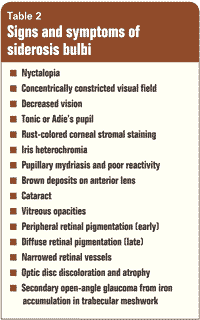
Siderosis bulbi is intraocular toxicity resulting from deposition of ionized iron inside the eye. Iron is mainly deposited onto the epithelial tissues of the eye, including the iris sphincter, dilator muscle, nonpigmented ciliary epithelium, lens epithelium, retina and retinal pigment epithelium. The latter two tissues are most susceptible to the damaging effects of iron toxicity.
Signs and symptoms of siderosis bulbi are listed in Figure 7. Our patient presented with decreased vision, rust-colored corneal stromal staining, iris heterochromia, pupillary mydriasis and poor reactivity, and vitreous opacities.
In general, risk factors for intraocular foreign bodies are not wearing protective eyewear and performing hammering activities, which tend to cause high-speed, small, metallic fragments to project into the eye. In addition, there is usually minimal corneal damage and a self-sealing wound.
The prognosis of intraocular foreign bodies depends on their size and location. Small, anteriorly located foreign bodies have better outcomes than larger, posteriorly located objects. The presenting visual acuity is the strongest predictor of the final visual acuity.
Management
The first step in the workup of intraocular foreign bodies is having a suspicion. As with our patient, suspected cases should have a thorough history and examination. In addition, plain films of the orbits, UBM of the intraocular tissues and ERG can be obtained. We did not order a CT of the orbits, but this imaging modality is often considered the method of choice for initial localization of intraocular foreign bodies.
Our patient presented with a 4-month history of progressive visual loss in his left eye. Based on the history, clinical examination and diagnostic tests, he was diagnosed with siderosis bulbi. One month after presentation, he underwent a vitrectomy with successful endoscopic visualization and removal of the metallic intraocular foreign bodies.
|
|
|
|
|
|
| ERG reveals near normal scotopic, maximal combined, photopic and 30 Hz flicker responses in the right eye (5a) and severely abnormal responses in the left eye (5b). | |
For more information:
- My Hanh T. Nguyen, MD, and Sarkis H. Soukiasian, MD, can be reached at New England Eye Center, Tufts University School of Medicine, 750 Washington St., Box 450, Boston, MA 02111; 617-636-4219; fax: 617-636-4866; Web site: www.neec.com.
- Edited by Shazia Ahmed, MD, and My Hanh T. Nguyen, MD. Drs. Ahmed and Nguyen can be reached at New England Eye Center, Tufts University School of Medicine, 750 Washington St., Box 450, Boston, MA 02111; 617-636-4219; fax: 617-636-4866; Web site: www.neec.com. Drs. Ahmed and Nguyen have no direct financial interest in the products mentioned in this article, nor are they paid consultants for any companies mentioned.
References:
- Behrens-Baumann W, Praetorius G. Intraocular foreign bodies. 297 consecutive cases. Ophthalmolgica. 1989;198:84-88.
- Chow DR, Garretson BR, et al. External versus internal approach to the removal of metallic intraocular foreign bodies. Retina. 2000;20:364-369.
- Deramo VA, Shah GK, et al. Ultrasound biomicroscopy as a tool for detecting and localizing occult foreign bodies after ocular trauma. Ophthalmology. 1999;106:301-305.
- Thompson JT, Parver LM, et al. Infectious endophthalmitis after penetrating injuries with retained intraocular foreign bodies. National Eye Trauma System. Ophthalmology. 1993;100:1468-1474.

